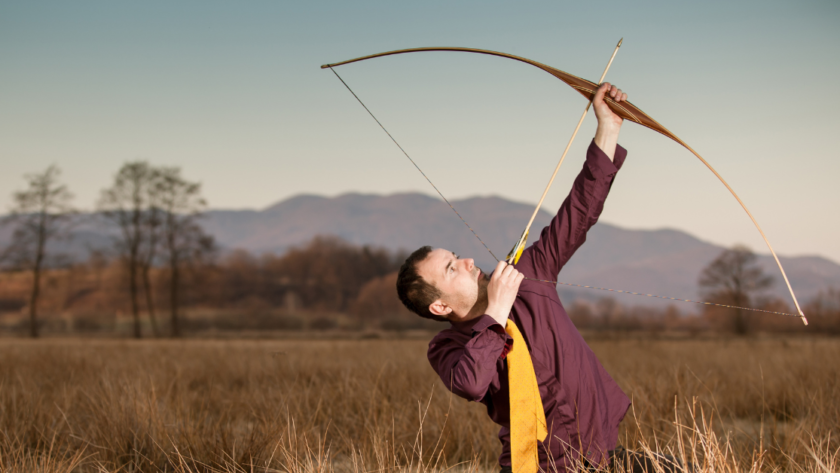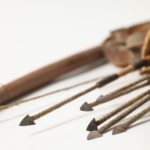As I run my fingers along the smooth curve of a handcrafted longbow, I’m struck by the incredible skill and artistry that goes into creating these elegant weapons.
Custom longbow making is a craft that seamlessly blends ancient techniques with modern innovation, resulting in bows that are both beautiful works of art and highly effective tools.
In this article, we’ll explore the fascinating world of custom longbow makers, taking a close look at the techniques, challenges, and passion that drive these skilled artisans.
Whether you’re an experienced archer or simply curious about traditional craftsmanship, you’re in for a treat as we uncover the secrets behind these remarkable pieces of functional art.
The Art and Science of Longbow Making
Custom longbow making needs a delicate balance of artistic vision and scientific understanding. Bowyers must possess a deep knowledge of wood properties, physics, and biomechanics while also having an eye for form and aesthetics.
Choosing the Right Wood
The foundation of any great longbow is the wood from which it’s crafted. Traditional favorites like yew and osage orange have been prized for centuries, but modern bowyers also work with a variety of exotic woods and laminated designs.
Yew has long been considered the gold standard for English longbows. It’s unique combination of sapwood and heartwood creates a natural composite that efficiently stores and releases energy.
This results in a bow that’s both powerful and smooth-shooting.
Osage orange, native to North America, is another top choice among bowyers. It’s dense, strong wood can withstand the repeated stress of drawing and releasing, making it ideal for durable hunting bows that can stand up to years of use in the field.
However, wood selection extends beyond just performance considerations. Many custom bowyers carefully consider the visual appeal and unique character of different woods when crafting their bows.
The rich, swirling grain of cocobolo or the striking contrast of a hickory and bamboo laminate can elevate a bow from a simple tool to a true work of art.
I’ve seen bows made from woods like ipe, purpleheart, and even reclaimed timber from old barns or shipwrecks. Each piece of wood brings it’s own story and character to the finished bow, making it truly one-of-a-kind.
The Tillering Process
Once the wood is selected and roughly shaped, the real magic of bowmaking begins with the tillering process. This crucial step involves carefully shaping the limbs to confirm they bend evenly and efficiently.
Tillering needs a keen eye, steady hand, and an abundance of patience. The bowyer repeatedly draws the bow, observing how the limbs bend, and makes minute adjustments until the curve is perfect.
This process can take days or even weeks, but it’s absolutely essential for creating a bow that shoots smoothly and accurately.
A well-tillered bow will store and release energy efficiently, resulting in faster arrow speeds and more consistent shots. It’s during this process that the bowyer’s skill and experience really shine through.
The ability to read the wood and make precise adjustments is what separates a good bow from a great one.
I’ve watched master bowyers at work during the tillering process, and it’s truly mesmerizing. Their hands move with a confidence born of years of experience, making tiny shavings here and there until the bow bends in a perfect arc.
It’s a process that can’t be rushed or automated – it needs the human touch and intuition that only comes from dedicated practice.
Balancing Tradition and Innovation
One of the most fascinating aspects of custom longbow making is the ongoing debate between traditional and modern techniques.
Some bowyers insist on using only traditional materials and methods, crafting bows that could have been made centuries ago.
These traditionalists argue that there’s a purity and connection to history in working with simple tools and natural materials.
On the other hand, many bowyers embrace modern innovations, incorporating materials like fiberglass or carbon fiber to enhance performance.
These hybrid designs often offer the best of both worlds – the classic feel and aesthetics of a traditional longbow with the improved durability and consistency of modern materials.
As a bowyer develops their craft, finding their place on this spectrum becomes part of developing a unique style and philosophy.
Some of the most interesting custom bows I’ve seen manage to seamlessly blend traditional craftsmanship with subtle modern enhancements.
For example, a bow might use traditional wood for the core but incorporate thin layers of modern materials for added strength and stability.
The Challenges of Custom Longbow Making
While the art of bowmaking is deeply rewarding, it comes with it’s fair share of challenges. Custom longbow makers face a variety of obstacles in their craft, from sourcing materials to preserving traditional skills.
Sourcing Quality Materials
One of the biggest challenges for modern bowyers is finding high-quality bow woods. Many traditional bow woods are becoming scarce or protected, making them difficult or expensive to obtain. This scarcity has led to some creative solutions among bowyers.
Many are exploring choice woods or even experimenting with reclaimed or urban-harvested timber. I’ve seen beautiful bows made from old floor joists or fallen trees in city parks.
This solves the sourcing problem and adds a unique story and character to each bow.
Some bowyers are also working with sustainable forestry projects to confirm a steady supply of traditional bow woods for future generations.
By supporting responsible harvesting practices, they’re helping to preserve both their craft and the environments that provide their materials.
Time and Patience
Creating a truly custom bow takes time – often weeks or even months from start to finish. This can be challenging in a market that often expects quick turnarounds.
Many bowyers have found success by educating their customers about the process and the value of a handcrafted bow.
By fostering an appreciation for the craft, they create a market that values quality over speed. Customers who understand the time and skill that goes into each bow are often more than willing to wait for their perfect custom piece.
I’ve spoken with bowyers who say that managing customer expectations is a crucial part of their business. They often provide regular updates and even photos of the bow-making process, helping the customer feel connected to their bow from the very beginning.
Preserving Traditional Skills
Another significant challenge is preserving the traditional skills of bowmaking for future generations. In an increasingly digital world, there’s a risk that these ancient techniques could be lost.
Many custom bowyers are addressing this by offering workshops or taking on apprentices. By sharing their knowledge and passion, they’re ensuring that the art of longbow making continues to thrive.
I’ve attended some of these workshops, and it’s inspiring to see the mix of ages and backgrounds of people keen to learn this ancient craft.
Some bowyers are also embracing social media and online platforms to share their techniques and connect with a wider audience.
YouTube channels and Instagram accounts dedicated to traditional bowmaking have gained significant followings, helping to spark interest in the craft among younger generations.
The Future of Custom Longbow Making
Despite the challenges, the future of custom longbow making looks bright. There’s a growing appreciation for handcrafted items and traditional skills, which bodes well for custom bowyers.
Embracing Technology
While the core of longbow making stays a hands-on craft, many bowyers are finding ways to incorporate modern technology into their process. Some are using 3D printing for certain bow components or prototyping.
While the core of the bow stays handcrafted, these technological aids can help streamline certain aspects of the process.
Computer-aided design (CAD) software is also becoming more common among bowyers. This allows for precise planning and modeling of bow designs before any wood is cut.
It’s particularly useful for complex laminated bows or when working with rare and expensive woods where mistakes could be costly.
Sustainability and Ethics
As awareness of environmental issues grows, many custom bowyers are placing a greater emphasis on sustainability.
This includes using responsibly sourced woods, exploring choices to endangered species, and minimizing waste in the bow-making process.
I’ve seen bowyers create beautiful bows using locally sourced woods or even invasive species that need to be removed from certain areas. This solves a sourcing problem and contributes to local conservation efforts.
There’s also an increasing focus on ethical sourcing of materials, particularly when it comes to exotic woods or animal products used in traditional bow making.
Many bowyers are working to confirm their entire supply chain aligns with their values and those of their customers.
This might mean using synthetic choices for certain components or partnering with specific suppliers who share their commitment to ethical practices.
Customization and Personalization
One of the greatest strengths of custom longbow making is the ability to create bows tailored to person archers.
As archery continues to grow in popularity, there’s likely to be an increased demand for bows that are perfectly suited to their owners.
This might include adjusting draw weights for different shooting styles, crafting grips to fit specific hand shapes, or incorporating personal design elements.
The sky’s the limit when it comes to customization, and this is an area where custom bowyers can really shine.
I’ve seen bows with intricate inlays depicting the owner’s favorite hunting scenes, bows sized perfectly for young archers just starting out, and even bows designed to accommodate physical disabilities.
This level of personalization is something that mass-produced bows simply can’t match.
Exercises for Aspiring Bowyers
If you’re interested in trying your hand at longbow making, here are a few exercises to get you started:
Wood Identification
Learning to identify different types of wood by their grain patterns and characteristics is crucial for selecting the right materials for your bows. Start by collecting samples of common bow woods and studying their properties.
Pay attention to the weight, hardness, and flexibility of each type.
Visit lumber yards or wood suppliers and practice identifying woods on sight. Many experienced bowyers can tell the difference between various species just by looking at and feeling the grain. This skill takes time to develop, but it’s invaluable for any serious bowyer.
Tillering Practice
Create a simple bow from a wooden board and practice the tillering process. This will help you understand how wood behaves under stress and how to shape it effectively.
Start with a straight-grained board of a relatively forgiving wood like oak or maple.
Rough out the basic bow shape, then slowly begin bending it and making small adjustments. Use a tillering tree (a simple rack that holds the bow at various draw lengths) to observe how the limbs bend.
Make small, careful adjustments with a rasp or file, constantly checking the bend of the limbs.
This exercise will teach you patience and give you a feel for how wood responds to shaping. It’s better to make mistakes on a simple board than on an expensive piece of yew or osage orange.
Design Sketching
Practice sketching bow designs, paying attention to the curve of the limbs and the overall profile. This will help you develop your eye for bow aesthetics and understand how different designs affect performance.
Start by copying classic bow designs, then begin experimenting with your own variations. Consider how changes in limb shape or length might affect the bow’s performance.
Even if you never intend to make these designs, the practice will help you understand bow geometry and proportions.
String Making
Learn to make your own bowstrings using traditional materials like linen or modern choices like Dacron. A well-made string is crucial for a bow’s performance, and making your own allows for finish customization.
Start with a simple Flemish twist string, which is made by twisting person strands together. Practice achieving consistent tension and learn how different materials affect string performance.
Making your own strings also allows you to experiment with different serving materials and techniques.
Finish Application
Experiment with different wood finishes on scrap pieces. Understanding how to protect and enhance the natural beauty of wood is an important part of bowmaking.
Try out various oils, varnishes, and waxes to see how they affect the wood’s appearance and feel.
Pay attention to how different finishes impact the wood’s ability to absorb moisture, as this can affect the bow’s performance over time. Some finishes may look beautiful but could make the bow slippery or change it’s flexibility.
Finding the right balance between protection, aesthetics, and performance is a key skill for any bowyer.
People Also Asked
What is the best wood for making a longbow?
Yew is traditionally considered the best wood for English longbows because of it’s natural combination of sapwood and heartwood. However, osage orange, hickory, and elm are also excellent choices.
The “best” wood often depends on the specific bow design and the archer’s preferences.
How long does it take to make a custom longbow?
The time to create a custom longbow varies greatly depending on the complexity of the design and the bowyer’s experience.
A simple bow might take 40-60 hours of work spread over several weeks, while more complex designs could take months to finish.
What is the average cost of a custom longbow?
Custom longbows can range from a few hundred dollars to several thousand, depending on the materials used, the bowyer’s reputation, and the complexity of the design. A high-quality custom longbow typically starts around $500-$800, with more elaborate bows costing $1500 or more.
How long does a well-made longbow last?
A well-made and properly cared for longbow can last for decades or even generations. Many traditional bows from the early 20th century are still in use today.
The lifespan depends on factors like wood quality, construction methods, and how well the bow is maintained.
What draw weight should I choose for my longbow?
The ideal draw weight depends on your strength, experience, and intended use for the bow. For target archery, many adults start with 25-35 pounds.
For hunting, draw weights of 40-60 pounds are common.
It’s best to start lighter and work your way up as you build strength and skill.
Can I learn to make a longbow at home?
Yes, many people learn to make longbows at home. There are numerous books, online tutorials, and workshops available for beginners.
However, it needs patience, practice, and a willingness to learn from mistakes.
Starting with a simple design and inexpensive wood is recommended for beginners.
What tools are needed to make a longbow?
Basic longbow making needs relatively few tools. Essential items include a drawknife, rasp, file, sandpaper, and a tillering stick.
As you advance, you might add specialized tools like a bow scale, heat gun, or power tools for roughing out staves.
How does a custom longbow compare to a modern compound bow?
Custom longbows and compound bows offer very different shooting experiences. Longbows are simpler, quieter, and many archers find them more satisfying to shoot.
However, compound bows generally offer greater speed, accuracy, and consistency, especially for beginners.
The choice often comes down to personal preference and intended use.
Key Takeaways
- Custom longbow making blends ancient techniques with modern innovation, creating bows that are both functional and artistic.
- Choosing the right wood and mastering the tillering process are crucial skills for bowyers.
- Balancing tradition and innovation allows bowyers to create unique, high-performance bows.
- Custom bowyers face challenges in sourcing materials and preserving traditional skills.
- The future of longbow making involves embracing technology while maintaining handcrafted quality.
- Aspiring bowyers can develop their skills through practical exercises and study.
- Custom longbows offer a unique, personalized archery experience that mass-produced bows can’t match.



